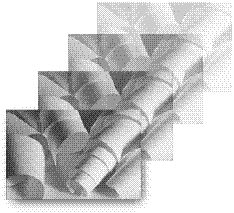
Over the last 10 years, sheet curl has become a significant issue for newsprint and other communication paper producers.With the increase in 4 colour printing that causes the sheet moisture to increas…
Over the last 10 years, sheet curl has become a significant issue for newsprint and other communication paper producers.
With the increase in 4 colour printing that causes the sheet moisture to increase by at least 1% with each application of a new colour on each side of the sheet during the offset printing process, many paper makers have had to deal with this issue. The problem is easily seen by the corners of newspaper copies turning over on the newsstands. This leads to complaints by advertisers who have advertisements in the corners that become hidden and readers that find the newspaper difficult to handle and read as the pages curl. Jamming of mailroom inserting equipment during production is also an issue. The concerns are received when the humidity in the air drops to low levels such as during cold winter days or in desert areas. Although many complex explanations for curl have been published the simple cause is the fact that as the sheet dries after the wetting during printing, one side shrinks more than the other causing internal forces leading the sheet to begin to curl up from the edges.
Printer solutions
Printers can take a number of steps to reduce or eliminate the problem in some cases. The most obvious solution is to reduce the amount of sheet wetting by lowering the amount of fountain solution used on the press to the minimum possible level. Another solution is to unwind the paper in the opposite direction as almost all sheets will only curl up from one side — so if this side is pointing toward the inside of the product printed, curl can not occur. Increasing humidity in the pressroom will lead to overall better sheet runnability, but once the printed product leaves the pressroom and goes to a low humidity environment the sheet will dry and the curl will occur.
Paper maker solutions
Paper makers in many cases must take action to help solve the printers’ concerns. Again, one of the easiest solutions, if the mill equipment allows, is to reverse wind the paper for affected customers so the curl direction during use is downward into the product being printed. This solution will not work everywhere however unless the unwind direction is known at all presses as this does vary. As paper has a tendency to curl towards the last side dried during production a change in drying arrangements may aid the situation, though the response can be minimal, so solving sheet structural issues is often the best solution. By equalizing fines content on both sheet sides during paper forming curl, will be reduced. Also, by operating paper machine head boxes in a rush condition, fibre orientation in the machine direction is reduced. As fibres mainly change dimension in the cross-direction after wetting, this can be an effective curl reduction strategy. On twin wire paper machines, it is important to have similar fibre orientation on both sheet sides to reduce curl.
Product testing
To prevent curl problems after printing, a number of mill tests can be performed to evaluate sheet curl before shipment. A large variety of tests are used, but most consist of cutting sheets of paper and measuring curl after the sheets have been exposed to a dry environment or dried under heat lamps. Ongoing monitoring of fibre orientation, fines content on the sheet outside layers and paper machine operating conditions will also prevent surprises after printing.
Philip Plouffe is a member of the Technical Section, Printing and Graphic Arts Committee, PAPTAC.
Print this page
